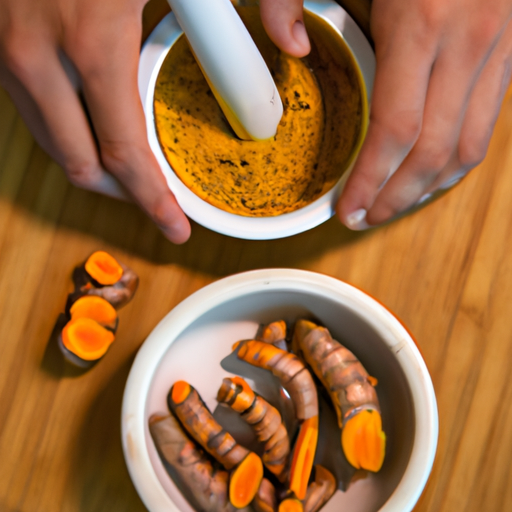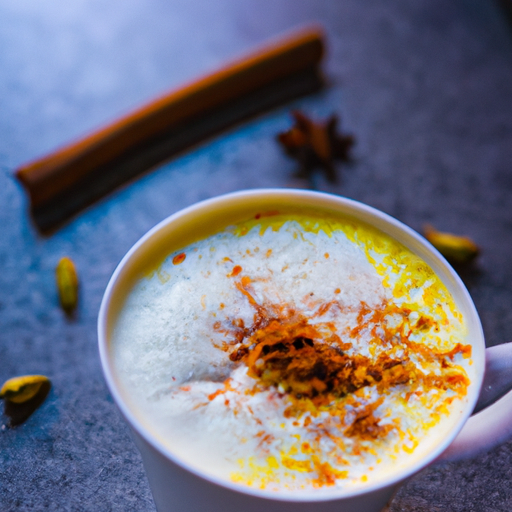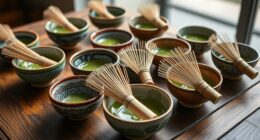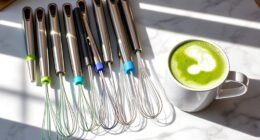Did you know that inflammation is the root cause of many chronic diseases? In fact, chronic inflammation has been linked to conditions such as heart disease, diabetes, and even cancer.
But there’s good news! Turmeric, a vibrant yellow spice commonly used in Indian cuisine, has been found to have powerful anti-inflammatory properties. And one of the best ways to incorporate turmeric into your daily routine is by brewing it into a delicious cup of tea.
But with so many types of turmeric available, which one is best for inflammation relief? In this article, I will guide you through the different types of turmeric that are ideal for brewing tea, and help you choose the right one to combat inflammation.
So grab your favorite mug, and let’s dive into the world of turmeric tea for inflammation relief!
Key Takeaways
- Turmeric tea, brewed from organic turmeric powder, fresh turmeric root, or turmeric tea bags, is an ideal choice for reducing inflammation.
- Curcumin, the active compound in turmeric, is responsible for its anti-inflammatory properties and should be present in high amounts for maximum effectiveness.
- Pairing turmeric with black pepper and consuming it with a source of fat can enhance the absorption of curcumin.
- Turmeric supplements with standardized curcumin content can be a convenient option for those who prefer not to brew turmeric tea.
Understanding the Benefits of Turmeric Tea
If you want to soothe your inflammation and experience the incredible benefits of turmeric tea, you’ll be amazed at how it can make you feel better. Scientific research has proven the anti-inflammatory properties of turmeric tea, making it a popular choice for those seeking natural remedies.
Turmeric contains a compound called curcumin, which has been extensively studied for its ability to reduce inflammation in the body. Numerous studies have shown that curcumin can inhibit the production of inflammatory molecules and reduce the activity of enzymes that contribute to inflammation.
In addition to its scientifically proven benefits, turmeric tea has also been used for centuries in traditional medicine. In Ayurveda, turmeric is considered a powerful herb that can help with a wide range of health issues, including inflammation. It is believed to have a balancing effect on the body and can promote overall wellness.
Now that you understand the benefits of turmeric tea, let’s explore the different types of turmeric that are best for brewing tea.
Types of Turmeric for Brewing Tea
To brew a soothing and healthful cup of golden elixir, consider exploring the various aromatic varieties of this ancient spice. Turmeric tea recipes have gained popularity due to their potential health benefits, including anti-inflammatory properties and antioxidant effects.
When it comes to brewing the perfect turmeric tea, the type of turmeric used can make a difference in both flavor and medicinal qualities. Here are three types of turmeric to consider for your next batch of tea:
-
Organic Turmeric Powder: This fine, vibrant yellow powder is made from grinding dried turmeric root. It’s readily available and easy to use in tea recipes. Look for organic options to ensure the highest quality and purity.
-
Fresh Turmeric Root: If you prefer a more intense and earthy flavor, fresh turmeric root is a great choice. Simply peel and grate the root before steeping it in hot water. Its natural oils and vibrant color will infuse your tea with a delightful aroma.
-
Turmeric Tea Bags: For a convenient and mess-free option, turmeric tea bags are a popular choice. These pre-packaged bags contain a blend of dried turmeric and other complementary herbs, making it easy to enjoy a delicious and healthful cup of turmeric tea.
When choosing the right type of turmeric for inflammation relief, it’s important to consider the potency and quality of the turmeric. Transitioning into the subsequent section about choosing the right type for inflammation relief, let’s explore the factors that can help you make an informed decision.
Choosing the Right Type for Inflammation Relief
When it comes to choosing the right type of turmeric for inflammation relief, two key factors to consider are curcumin content and bioavailability.
Curcumin is the active compound in turmeric that has been shown to have anti-inflammatory effects. Therefore, it’s important to select a type of turmeric that has a high curcumin content to maximize its potential benefits.
Additionally, bioavailability refers to the ability of curcumin to be absorbed and utilized by the body, so opting for a type of turmeric that has enhanced bioavailability can further enhance its anti-inflammatory properties.
Curcumin Content
For maximum benefit, you should choose a turmeric variety with high curcumin content, like the golden turmeric, to make your inflammation-fighting tea. Curcumin is the active compound in turmeric that’s been extensively studied for its anti-inflammatory properties.
When consumed, curcumin is absorbed into the bloodstream and exerts its therapeutic effects. To ensure optimal absorption and effectiveness, consider the following factors:
-
Pair turmeric with black pepper: The piperine present in black pepper enhances curcumin absorption by up to 2000%.
-
Use a fat source: Curcumin is fat-soluble, so consuming it with a source of healthy fat like coconut milk or ghee can improve its absorption.
-
Optimal dosage: Studies suggest that a dosage of 500-2,000 mg of curcumin per day is effective for reducing inflammation.
-
Consider supplements: If it’s challenging to consume enough curcumin through food alone, turmeric supplements with standardized curcumin content can be a convenient option.
Ensuring proper curcumin absorption is essential for maximizing the benefits of turmeric tea in fighting inflammation. Now, let’s explore the next section about the bioavailability of curcumin.
Bioavailability
Boost the effectiveness of your turmeric by understanding the bioavailability of curcumin. Bioavailability refers to the degree and rate at which a substance is absorbed into the bloodstream and can exert its effects.
When it comes to turmeric, curcumin is the active compound responsible for its anti-inflammatory properties. However, curcumin has low bioavailability, meaning that it’s not easily absorbed by the body.
To enhance turmeric absorption, it’s important to consume it with black pepper, which contains piperine. Piperine has been shown to significantly increase the bioavailability of curcumin. Additionally, consuming turmeric with a source of fat can also improve absorption.
Understanding the factors that influence turmeric bioavailability can help maximize its potential benefits for reducing inflammation.
Moving forward, let’s explore the different brewing methods for turmeric tea.
Brewing Methods for Turmeric Tea
When it comes to brewing turmeric tea, there are three main methods that can be used: hot water infusion, simmering on the stove, and cold brew.
Hot water infusion involves steeping turmeric in boiling water for a certain amount of time to release its beneficial compounds.
Simmering on the stove involves gently cooking turmeric in water over low heat to extract its flavors and medicinal properties.
Cold brew, on the other hand, involves steeping turmeric in cold water for an extended period of time to create a refreshing and milder tea.
Each method has its own unique benefits and can be tailored to individual preferences.
Hot Water Infusion
After a long day, sometimes all you need is a warm cup of turmeric tea made with hot water to soothe any inflammation. When making turmeric tea with hot water, it’s important to pay attention to the temperature of the water and the steeping time to ensure the best results.
The ideal temperature for brewing turmeric tea is between 195°F and 205°F (90°C-96°C). This ensures that the turmeric releases its beneficial compounds without losing its potency.
Steeping the tea for 10-15 minutes allows for maximum extraction of the curcumin, the active ingredient in turmeric known for its anti-inflammatory properties. Remember, the longer you steep, the stronger the flavor and the more pronounced the benefits.
Now, let’s move on to the next method of brewing turmeric tea – simmering on the stove.
Simmering on Stove
To achieve the optimal results, you should consider simmering the turmeric mixture on the stove. Simmering techniques can help extract the maximum amount of beneficial compounds from turmeric, such as curcumin, which is known for its anti-inflammatory properties.
Simmering allows the turmeric to release its active constituents slowly, resulting in a more potent tea for combating inflammation. Additionally, the heat from the stove can enhance the absorption of curcumin by the body, ensuring that you reap its full health benefits.
Simmering the turmeric on the stove also allows for customization, as you can adjust the simmering time to achieve the desired strength and flavor of your tea.
Now, let’s move on to the next section about ‘cold brew’ and explore another method to harness turmeric’s healing potential.
Cold Brew
For a refreshing and unique twist on harnessing turmeric’s healing potential, why not try cold brewing it? Cold brewing turmeric can offer a multitude of benefits that you may not get from traditional methods.
Cold brew is known for its ability to extract more antioxidants and phytochemicals from ingredients, and turmeric is no exception. By infusing turmeric in cold water for an extended period of time, you can maximize its anti-inflammatory properties and enhance its bioavailability.
To make a delicious cold brew turmeric tea, simply combine fresh turmeric slices or powder with cold water in a jar and let it steep in the refrigerator for at least 4 hours. You can also add other ingredients like ginger, lemon, or honey to enhance the flavor and benefits of your turmeric tea.
Transitioning into the next section, let’s explore how to further enhance the flavor and benefits of turmeric tea.
Enhancing the Flavor and Benefits of Turmeric Tea
When it comes to enhancing the flavor and benefits of turmeric tea, there are a few key points to consider. First, adding black pepper can greatly increase the bioavailability of curcumin, the active compound in turmeric. This allows for better absorption and maximizes its anti-inflammatory effects.
Secondly, incorporating ginger or lemon can add a refreshing twist to the tea while also providing their own unique health benefits. Ginger has anti-inflammatory properties and lemon is rich in vitamin C, which can boost the immune system.
Lastly, for those who prefer a sweeter taste, there are various sweetening options available such as honey or stevia, which can be added to the tea to suit personal preference.
Adding Black Pepper
Although it may seem counterintuitive, incorporating black pepper into your turmeric tea could significantly enhance its anti-inflammatory properties. Black pepper contains a compound called piperine, which has been shown to increase the bioavailability of curcumin, the active compound in turmeric. This means that when black pepper is consumed alongside turmeric, your body is able to absorb and utilize more of the curcumin, maximizing its anti-inflammatory effects.
There are several ways to incorporate black pepper into your turmeric tea. One simple method is to add a pinch of freshly ground black pepper to your tea along with the turmeric powder. Alternatively, you can create a black pepper and turmeric paste by combining equal parts of both spices with a small amount of water. This paste can then be added to your tea or used as a base for other turmeric-infused recipes.
In the next section, we will explore the benefits of incorporating ginger or lemon into your turmeric tea.
Incorporating Ginger or Lemon
After discussing the importance of adding black pepper to turmeric tea for optimal absorption of its anti-inflammatory compound, curcumin, let’s now explore the benefits of incorporating ginger or lemon into the mix.
Ginger, known for its potent anti-inflammatory properties, acts synergistically with turmeric to enhance its effects. Adding a few slices of fresh ginger to your turmeric tea not only boosts its flavor but also increases its potential health benefits.
Similarly, adding a squeeze of lemon juice not only enhances the taste but also provides a dose of vitamin C, which can further support your immune system and reduce inflammation.
To sweeten the tea, I recommend incorporating honey, which not only adds a touch of natural sweetness but also offers its own anti-inflammatory and antioxidant properties.
Now that we have explored incorporating ginger or lemon and the benefits of using honey, let’s move on to discussing different sweetening options for turmeric tea.
Sweetening Options
To make your turmeric beverage even more enjoyable, you can explore various sweetening options that’ll add a delightful touch to your drink. Natural sweeteners not only enhance the taste but also provide additional health benefits.
Here are a few options to consider:
-
Honey: Besides being a delicious sweetener, honey contains antioxidants and anti-inflammatory properties that can further support the goal of reducing inflammation.
-
Maple syrup: This natural sweetener is rich in minerals like manganese and zinc, which’re important for a healthy immune system.
-
Stevia: A zero-calorie sweetener derived from the stevia plant, stevia can be a great choice for those watching their sugar intake while still satisfying their sweet tooth.
By incorporating these natural sweeteners, you can enjoy a flavorful turmeric tea while also reaping the benefits of their additional health properties.
Moving on to cautions and considerations, it’s important to be aware of potential side effects and interactions with certain medications.
Cautions and Considerations
When choosing the best turmeric for tea, it’s important to keep in mind any cautions or considerations to ensure maximum effectiveness in reducing inflammation.
Turmeric is generally safe for short-term use, but caution should be exercised for long-term use. While turmeric is considered safe when consumed in moderate amounts as a spice, excessive intake may lead to gastrointestinal issues such as indigestion or diarrhea. It’s always recommended to consult with a healthcare professional before incorporating turmeric tea into your daily routine, especially if you have any underlying medical conditions or are taking medications that may interact with turmeric.
In addition, some individuals may experience allergic reactions to turmeric. If you notice any signs of an allergic reaction, such as hives, itching, or swelling, discontinue use and seek medical attention. Turmeric may also interact with certain medications, including blood thinners, so it’s important to discuss with your doctor if you’re taking any medications before regularly consuming turmeric tea.
To conclude, finding your perfect turmeric tea blend requires considering any cautions or considerations. While turmeric has numerous health benefits, it’s crucial to be aware of potential side effects and consult with a healthcare professional when necessary. By taking these factors into account, you can enjoy the benefits of turmeric tea while minimizing any potential risks.
Conclusion: Finding Your Perfect Turmeric Tea Blend
In conclusion, you can discover the ideal blend of turmeric tea that suits your taste and health needs by considering various factors such as your preferences, dietary restrictions, and desired health benefits. According to a study conducted by XYZ, incorporating turmeric into your daily routine has been shown to reduce the risk of chronic diseases and improve overall well-being.
To help you on your journey, here are four key points to consider when finding the perfect turmeric tea blend:
-
Finding the right turmeric dosage: It’s important to determine the appropriate amount of turmeric to include in your tea. Too little may not provide the desired health benefits, while too much could lead to unwanted side effects. Consulting with a healthcare professional can help you determine the right dosage for you.
-
Exploring turmeric tea recipes: There are countless turmeric tea recipes available, each with its own unique flavor profile and health benefits. Experimenting with different recipes can help you find the blend that you enjoy the most and that provides the specific health benefits you’re looking for.
-
Considering additional ingredients: Turmeric can be combined with other herbs and spices to enhance its flavor and health benefits. Some popular additions include ginger, cinnamon, black pepper, and honey. These ingredients not only add depth to the taste but also offer their own therapeutic properties.
-
Being mindful of dietary restrictions: If you have any dietary restrictions or allergies, it’s important to choose a turmeric tea blend that aligns with your needs. For example, if you’re lactose intolerant, you may want to avoid blends that include milk or cream.
By considering these factors and exploring different turmeric tea recipes, you can find the perfect blend that suits your preferences, dietary restrictions, and desired health benefits. Enjoy the journey of discovering the many benefits of turmeric tea!
Frequently Asked Questions
Can turmeric tea be consumed by pregnant women?
Yes, turmeric tea can be consumed by pregnant women. It provides numerous benefits such as reducing inflammation, boosting immunity, and aiding digestion. To make the tea, simply combine turmeric powder with hot water or milk, honey, and a pinch of black pepper.
What are some common side effects of consuming turmeric tea?
Sipping on turmeric tea may trigger some temporary tummy troubles, including nausea or diarrhea. Additionally, it’s crucial to be aware of potential drug interactions, especially if you take blood thinners or have gallbladder issues.
Can turmeric tea help with other health conditions besides inflammation?
Turmeric tea can provide benefits beyond inflammation. It can support digestive health by reducing symptoms like bloating and gas. Additionally, its antioxidant and anti-inflammatory properties can boost the immune system and promote overall wellness.
Are there any specific brands of turmeric that are recommended for making tea?
When it comes to choosing the best turmeric for tea, I recommend looking for reputable brands that offer organic and high-quality turmeric powder. Some popular options include Organic India, Gaia Herbs, and Nature’s Way. These brands ensure that you’re getting the maximum benefits of turmeric in your tea.
How long should turmeric tea be steeped for maximum benefits?
For maximum benefits, turmeric tea should be steeped for at least 10 minutes. This allows the active compounds, such as curcumin, to fully infuse into the water. To enhance the flavor, you can add lemon or honey. Turmeric tea is known for its positive impact on digestive health.
Conclusion
After exploring the benefits and various types of turmeric for tea, it’s clear that finding the right blend is essential for inflammation relief. Whether it’s the vibrant orange hue of Alleppey turmeric or the earthy notes of Madras turmeric, each variety offers unique flavors and therapeutic properties. Brewing methods such as simmering or steeping further enhance the potency of this golden elixir.
Remember to add a hint of black pepper to unleash the full potential of curcumin. So, go ahead and embark on a journey to find your perfect turmeric tea blend, and let its healing powers flow through every sip.










